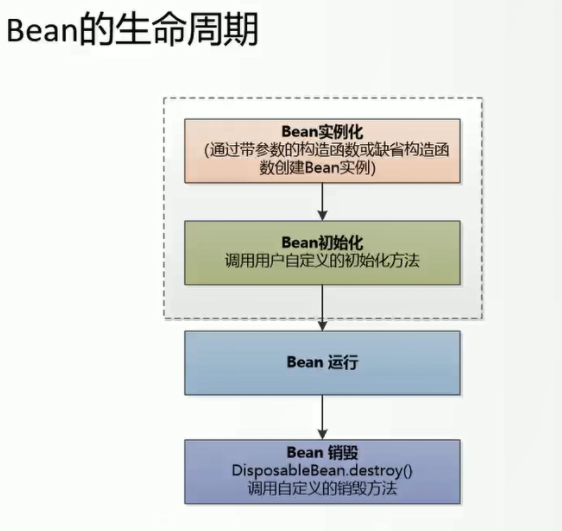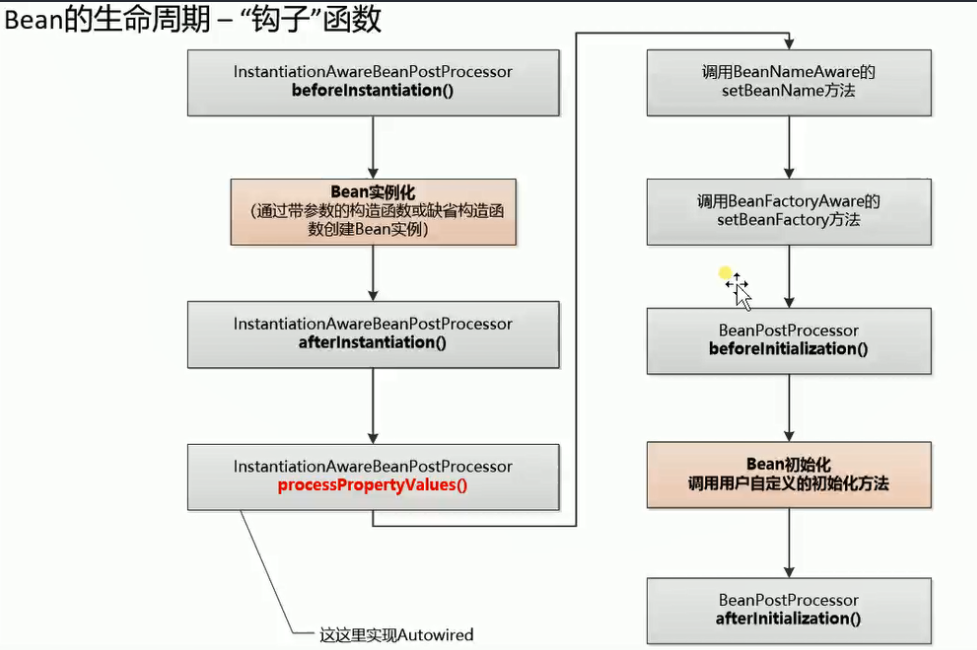Spring的轻量级实现
作者: Grey
原文地址:Spring的轻量级实现
本文是参考公众号:码农翻身 的从零开始造Spring 教程的学习笔记
源码
开发方法
使用TDD的开发方法,TDD的开发流程是:
写一个测试用例
运行:失败
写Just enough的代码,让测试通过
重构代码保持测试通过,
然后循环往复。
说明
仅实现核心功能
基于spring-framework-3.2.18.RELEASE版本
通过XML实例化一个对象
解析XML文件,拿到Bean的id和完整路径,通过反射方式实例化一个对象。
XML格式如下,文件名为:bean-v1.xml
<?xml version="1.0" encoding="UTF-8"?><beans xmlns="http://www.springframework.org/schema/beans"xmlns:xsi="http://www.w3.org/2001/XMLSchema-instance"xsi:schemaLocation="http://www.springframework.org/schema/beanshttp://www.springframework.org/schema/beans/spring-beans.xsd"><bean id="userService" class="org.spring.service.v1.UserService"></bean></beans>
需要解析上述XML并生成userService对象,调用者只需要做如下调用即可:
public class BeanFactoryV1Test {@Testpublic void testGetBean() {BeanFactory factory = new DefaultBeanFactory("bean-v1.xml");UserService userService = (UserService) factory.getBean("userService");assertNotNull(userService);}}
思路为:
解析XML,并把XML中的类通过反射方式生成对象,最后,把这个生成的对象放到一个Map中,其中Map的key为beanId,如上例就是:userService, Map的Value是UserService的全路径org.spring.service.v1.UserService
实现细节参考代码见:step1
基础工作和基本封装
- 增加日志支持:log4j2 + SLF4j
- 增加异常处理,所有异常的父类设计为
BeansException - 封装BeanDefinition
由于DefaultBeanFactory中的BEAN_MAP目前只包括了beanClassName信息,后续如果要扩展其他的信息,肯定需要增加字段,所以我们需要抽象出一个接口BeanDefinition,方便后续扩展其他的字段。
- 封装Resource
在BeanFactory初始化的时候,传入的是XML格式的配置信息,比如bean-v1.xml, Spring会把这个抽象成一个Resource,常见Resource有
FileSystemResource: 从文件地址读配置
ClassPathResource: 从classpath下读配置
BeanFactory在创建Bean的时候,只关注Resource即可。
实现细节参考代码见:vstep4-2-resource
封装XML的解析逻辑和Bean的注册逻辑
设计XmlBeanDefinitionReader,用于解析XML,传入Resource,即可获取所有BeanDefinition,
public void loadBeanDefinitions(Resource resource) {// 从Resource中获取所有的BeanDefinition// 注册到BEAN_MAP中}
由于要把BeanDefinition放入BEAN_MAP中,所以XmlBeanDefinitionReader需要持有一个DefaultBeanFactory,且DefaultBeanFactory需要有注册BeanDefinition和获取BeanDefintion的能力,这样DefaultBeanFactory的职责就不单一了,所以需要抽象出一个BeanDefinitionRegistry,这个BeanDefinitionRegistry专门负责注册BeanDefinition和获取BeanDefintion,
public interface BeanDefinitionRegistry {/*** 注册Bean* @param beanId* @param beanDefinition*/void registerBeanDefinition(String beanId, BeanDefinition beanDefinition);}
XmlBeanDefinitionReader只需要持有BeanDefinitionRegistry,即可将解析生成的BeanDefinition注入BEAN_MAP中。
实现细节参考代码见:vstep5-final
单例多例模式的配置实现
XML文件中会增加一个属性,如下:
<?xml version="1.0" encoding="UTF-8"?><beans xmlns="http://www.springframework.org/schema/beans"xmlns:xsi="http://www.w3.org/2001/XMLSchema-instance"xsi:schemaLocation="http://www.springframework.org/schema/beanshttp://www.springframework.org/schema/beans/spring-beans.xsd"><bean id="userService" class="org.spring.service.v1.UserService"></bean><bean id="orgService" class="org.spring.service.v1.OrgService" scope="prototype"></bean></beans>
其中orgService这个bean配置成了prototype的属性,所以在BeanDefinition这个数据结构要增加是否单例,是否多例的逻辑
public interface BeanDefinition {...boolean isSingleton();boolean isPrototype();...}
在DefaultBeanFactory调用getBean的时候,判断是否单例,如果是单例,则复用对象,如果是多例,则new新的对象。
@Overridepublic Object getBean(String beanId) {// TODO bean存在与否判断// TODO 异常处理// TODO 构造函数带参数BeanDefinition definition = BEAN_MAP.get(beanId);if (definition.isSingleton()) {Object bean = this.getSingleton(beanId);if(bean == null){bean = createBean(definition);this.registerSingleton(beanId, bean);}return bean;}return createBean(definition);}
抽象SingletonBeanRegistry这个接口,专门用于注册和获取单例对象,
public interface SingletonBeanRegistry {void registerSingleton(String beanName, Object singletonObject);Object getSingleton(String beanName);}
DefaultSingletonBeanRegistry实现这个接口,实现对单例对象的注册
public class DefaultSingletonBeanRegistry implements SingletonBeanRegistry {// TODO 考虑线程安全的容器private final Map<String, Object> singletonObjects = new HashMap<>();@Overridepublic void registerSingleton(String beanName, Object singletonObject) {// 注册单例Bean...}@Overridepublic Object getSingleton(String beanName) {// 获取单例Beanreturn this.singletonObjects.get(beanName);}}
DefaultBeanFactory继承DefaultSingletonBeanRegistry这个类,就有了获取单例Bean和注册单例Bean的能力。
实现细节参考代码见:vstep6-scope
整合并抽象出ApplicationContext
我们使用Spring的时候,一般是这样做的:
ApplicationContext ctx = new ClassPathXmlApplicationContext("mycontainer.xml");UserService userService = (UserService) ctx.getBean("userService");
或
ApplicationContext ctx = new FileSystemApplicationContext("src\\test\\resources\\bean-v1.xml");UserService userService = (UserService) ctx.getBean("userService");
现在,我们需要抽象出ApplicationContext这个接口来实现如上的功能,其中有如下两个类去实现这个接口。
ClassPathXmlApplicationContext
从classpath中读取配置文件
FileSystemApplicationContext
从文件中读取配置文件
这两个子类都需要持有DefaultBeanFactory才能有getBean的能力,
ClassPathXmlApplicationContext代码如下:
public class ClassPathXmlApplicationContext implements ApplicationContext {private final DefaultBeanFactory factory;public ClassPathXmlApplicationContext(String configPath) {factory = new DefaultBeanFactory();XmlBeanDefinitionReader reader = new XmlBeanDefinitionReader(factory);reader.loadBeanDefinitions(new ClassPathResource(configPath));}@Overridepublic Object getBean(String beanId) {return factory.getBean(beanId);}}
FileSystemApplicationContext代码如下:
public class FileSystemApplicationContext implements ApplicationContext {private final DefaultBeanFactory factory;public FileSystemApplicationContext(String configPath) {factory = new DefaultBeanFactory();XmlBeanDefinitionReader reader = new XmlBeanDefinitionReader(factory);reader.loadBeanDefinitions(new FileSystemResource(configPath));}@Overridepublic Object getBean(String beanId) {return factory.getBean(beanId);}}
实现细节参考代码见:vstep7-applicationcontext-v1
通过观察发现,ClassPathXmlApplicationContext和FileSystemApplicationContext大部分代码都是相同的,只有在获取Resource的时候,方法不一样,所以,我们通过模板方法这个设计模式,设计一个抽象类AbstractApplicationContext,代码如下:
public abstract class AbstractApplicationContext implements ApplicationContext {private DefaultBeanFactory factory;public AbstractApplicationContext(String configPath) {factory = new DefaultBeanFactory();XmlBeanDefinitionReader reader = new XmlBeanDefinitionReader(factory);reader.loadBeanDefinitions(getResourceByPath(configPath));}@Overridepublic Object getBean(String beanId) {return factory.getBean(beanId);}protected abstract Resource getResourceByPath(String path);}
这个抽象类实现除了获取Resource以外的所有逻辑,ClassPathXmlApplicationContext和FileSystemApplicationContext都继承这个抽象类,完成Resource的获取逻辑的编写即可。以FileSystemApplicationContext为例,示例代码如下:
public class FileSystemApplicationContext extends AbstractApplicationContext {public FileSystemApplicationContext(String configPath) {super(configPath);}@Overrideprotected Resource getResourceByPath(String path) {return new FileSystemResource(path);}}
实现细节参考代码见:vstep7-applicationcontext-v2
注入Bean和字符串常量
我们需要对于如下类型的XML配置文件进行解析:
<?xml version="1.0" encoding="UTF-8"?><beans xmlns="http://www.springframework.org/schema/beans"xmlns:xsi="http://www.w3.org/2001/XMLSchema-instance"xsi:schemaLocation="http://www.springframework.org/schema/beanshttp://www.springframework.org/schema/beans/spring-beans.xsd"><bean id="userService" class="org.spring.service.v2.UserService"><property name="accountDao" ref="accountDao"/><property name="itemDao" ref="itemDao"/><property name="owner" value="test"/><property name="version" value="2"/><property name="checked" value="on"/></bean><bean id="accountDao" class="org.spring.dao.v2.AccountDao"></bean><bean id="itemDao" class="org.spring.dao.v2.ItemDao"></bean></beans>
需要达到的目的就是:可以把整型,字符串类型,简单对象类型注入到一个Bean中,我们需要解决如下两个问题:
第一个问题是:把字符串转成各种各样的Value,比如把String转换成Integer或者转换成Boolean。jdk中java.bean包中的PropertyEditorSupport这个类来完成的,我们新建了CustomBooleanEditor和CustomNumberEditor两个类,这两个类都继承于PropertyEditorSupport,分别实现了String类型转换成Boolean类型和String类型转换成Integer类型的功能。其他的类型转换也可以通过类似的方法来实现。然后抽象出了TypeConvert这个接口,并把这些转换器加入一个特定的Map中,Map的key就是要转换的目标的类型,Value就是对应的转换器的实现类,即可实现类型转换。
public interface TypeConverter {// TODO 抽象出:TypeMismatchException<T> T convertIfNecessary(Object value, Class<T> requiredType);}
第二个问题是:我们调用Bean的setXXX方法把这些Value值set到目标Bean中,做法是抽象出PropertyValue
public class PropertyValue {private final String name;private final Object value;// 省略构造方法和get/set方法}
BeanDefiniton需要增加方法获取PropertyValue的逻辑,BeanDefiniton的所有子类,例如:GenericBeanDefinition中需要增加
private List<PropertyValue> propertyValues = new ArrayList<>();
在解析XML文件的时候,就需要把List<PropertyValue>识别出来并加入BeanDefinition中(RuntimeBeanReference,TypedStringValue),使用BeanDefinitionValueResolver把对应的PropertyValue给初始化好,如下代码:
public class BeanDefinitionValueResolver {...public Object resolveValueIfNecessary(Object value) {if (value instanceof RuntimeBeanReference) {...} else if (value instanceof TypedStringValue) {return ((TypedStringValue) value).getValue();} else {//TODOthrow new RuntimeException("the value " + value + " has not implemented");}}...}
而setXXX的背后实现利用的是jdk原生java.beans.Introspector来实现,见DefaultBeanFactory的populateBean方法
private void populateBean(BeanDefinition bd, Object bean) {....try {for (PropertyValue pv : pvs) {String propertyName = pv.getName();Object originalValue = pv.getValue();Object resolvedValue = valueResolver.resolveValueIfNecessary(originalValue);BeanInfo beanInfo = Introspector.getBeanInfo(bean.getClass());PropertyDescriptor[] pds = beanInfo.getPropertyDescriptors();for (PropertyDescriptor pd : pds) {if (pd.getName().equals(propertyName)) {Object convertedValue = converter.convertIfNecessary(resolvedValue, pd.getPropertyType());pd.getWriteMethod().invoke(bean, convertedValue);break;}}}} catch (Exception ex) {// TODO 封装Exceptionthrow new RuntimeException("Failed to obtain BeanInfo for class [" + bd.getBeanClassName() + "]", ex);}}
其中
pd.getWriteMethod().invoke(bean, convertedValue);
就是对bean的属性进行赋值操作(即:setXXX方法)
实现细节参考代码见:vstep8-inject
实现构造器注入
处理形如以下的配置:
<bean id="userService" class="org.spring.service.v3.UserService"><constructor-arg ref="accountDao"/><constructor-arg ref="itemDao"/><constructor-arg value="1"/></bean><bean id="accountDao" class="org.spring.dao.v3.AccountDao"></bean><bean id="itemDao" class="org.spring.dao.v3.ItemDao"></bean>
和上例中注入Bean和字符串常量一样,我们抽象出ConstructorArgument用于表示一个构造函数信息,每个BeanDefinition中持有这个对象,
public class ConstructorArgument {private final List<ValueHolder> argumentValues = new LinkedList<>();public ConstructorArgument() {}public void addArgumentValue(ValueHolder valueHolder) {this.argumentValues.add(valueHolder);}public List<ValueHolder> getArgumentValues() {return Collections.unmodifiableList(this.argumentValues);}public int getArgumentCount() {return this.argumentValues.size();}public boolean isEmpty() {return this.argumentValues.isEmpty();}/*** Clear this holder, removing all argument values.*/public void clear() {this.argumentValues.clear();}public static class ValueHolder {private Object value;private String type;private String name;// 省略get/set和构造方法}}
在解析XML的时候,XmlBeanDefinitionReader需要负责解析出ConstuctorArgument,DefaultBeanFactory通过指定构造函数来生成Bean对象并通过ConstructorResolver注入Bean实例到构造方法中。
public class ConstructorResolver {....public Object autowireConstructor(final BeanDefinition bd) {// ...通过bd找到一个合适的构造函数try {// 找到了一个合适的构造函数,则用这个构造函数初始化Bean对象初始化Bean对象return constructorToUse.newInstance(argsToUse);} catch (Exception e) {// TODO throw new BeanCreationException(bd.getID(), "can't find a create instance using " + constructorToUse); }throw new RuntimeException(bd.getID() + "can't find a create instance using " + constructorToUse);}}....}
注:这里指定的构造函数的查找逻辑为:解析出XML的构造函数的参数列表,和通过反射拿到对应的构造函数的参数列表进行对比(每个参数的类型和个数必须一样)
Constructor<?>[] candidates = beanClass.getConstructors();BeanDefinitionValueResolver valueResolver = new BeanDefinitionValueResolver(this.beanFactory);ConstructorArgument cargs = bd.getConstructorArgument();TypeConverter typeConverter = new SimpleTypeConverter();for (int i = 0; i < candidates.length; i++) {// 匹配参数类型和个数,要完全对应上才可以Class<?>[] parameterTypes = candidates[i].getParameterTypes();if (parameterTypes.length != cargs.getArgumentCount()) {continue;}argsToUse = new Object[parameterTypes.length];boolean result = this.valuesMatchTypes(parameterTypes,cargs.getArgumentValues(),argsToUse,valueResolver,typeConverter);if (result) {constructorToUse = candidates[i];break;}}
实现细节参考代码见:vstep9-constructor
实现注解
实现两个注解:@Component @Autowired(只针对属性注入,暂时不考虑方法注入)
且需要实现如下的XML的解析,即实现某个包下的Bean扫描。
<?xml version="1.0" encoding="UTF-8"?><beans xmlns="http://www.springframework.org/schema/beans"xmlns:xsi="http://www.w3.org/2001/XMLSchema-instance"xmlns:context="http://www.springframework.org/schema/context"xsi:schemaLocation="http://www.springframework.org/schema/beanshttp://www.springframework.org/schema/beans/spring-beans.xsdhttp://www.springframework.org/schema/contexthttp://www.springframework.org/schema/context/spring-context.xsd"><context:component-scan base-package="org.spring.service.v4,org.spring.dao.v4"></context:component-scan></beans>
我们首先需要定义注解Component ,Autowired,代码如下:
@Target({ElementType.CONSTRUCTOR, ElementType.FIELD, ElementType.METHOD, ElementType.ANNOTATION_TYPE})@Retention(RetentionPolicy.RUNTIME)@Documentedpublic @interface Autowired {boolean required() default true;}
@Target(ElementType.TYPE)@Retention(RetentionPolicy.RUNTIME)@Documentedpublic @interface Component {String value() default "";}
其次,我们需要实现一个功能,即:给一个包名,扫描获取到这个包以及子包下面的所有Class,示例代码如下:
public Resource[] getResources(String basePackage) throws IOException {Assert.notNull(basePackage, "basePackage must not be null");// 把包名中的.转成/, 即可获取包的路径String location = ClassUtils.convertClassNameToResourcePath(basePackage);// TODO ClassLoader cl = getClassLoader();URL url = Thread.currentThread().getContextClassLoader().getResource(location);File rootDir = new File(url.getFile());Set<File> matchingFiles = retrieveMatchingFiles(rootDir);Resource[] result = new Resource[matchingFiles.size()];int i = 0;for (File file : matchingFiles) {result[i++] = new FileSystemResource(file);}return result;}
主要思路是将包名转换成文件路径,然后递归获取路径下的Class文件。
protected Set<File> retrieveMatchingFiles(File rootDir) throws IOException {if (!rootDir.exists()) {// Silently skip non-existing directories./*if (logger.isDebugEnabled()) {logger.debug("Skipping [" + rootDir.getAbsolutePath() + "] because it does not exist");}*/return Collections.emptySet();}if (!rootDir.isDirectory()) {// Complain louder if it exists but is no directory./* if (logger.isWarnEnabled()) {logger.warn("Skipping [" + rootDir.getAbsolutePath() + "] because it does not denote a directory");}*/return Collections.emptySet();}if (!rootDir.canRead()) {/*if (logger.isWarnEnabled()) {logger.warn("Cannot search for matching files underneath directory [" + rootDir.getAbsolutePath() +"] because the application is not allowed to read the directory");}*/return Collections.emptySet();}/*String fullPattern = StringUtils.replace(rootDir.getAbsolutePath(), File.separator, "/");if (!pattern.startsWith("/")) {fullPattern += "/";}fullPattern = fullPattern + StringUtils.replace(pattern, File.separator, "/");*/Set<File> result = new LinkedHashSet<>(8);doRetrieveMatchingFiles(rootDir, result);return result;}protected void doRetrieveMatchingFiles(File dir, Set<File> result) throws IOException {File[] dirContents = dir.listFiles();if (dirContents == null) {/* if (logger.isWarnEnabled()) {logger.warn("Could not retrieve contents of directory [" + dir.getAbsolutePath() + "]");}*/return;}for (File content : dirContents) {if (content.isDirectory()) {if (!content.canRead()) {/* if (logger.isDebugEnabled()) {logger.debug("Skipping subdirectory [" + dir.getAbsolutePath() +"] because the application is not allowed to read the directory");}*/} else {doRetrieveMatchingFiles(content, result);}} else {result.add(content);}}}
由于注解的Bean不像之前的xml定义的Bean那样,会对Bean配置一个id,所以,这里解析出来的Bean定义需要自动生成一个BeanId(默认先取注解中的value的配置,否则就就是类名第一个字母小写,抽象BeanNameGenerator来专门对Bean定义ID),同时,Spring中单独新建了一个AnnotatedBeanDefinition接口来定义包含注解的BeanDefinition。
我们得到了对应的Class文件,我们需要通过某种方式去解析这个Class文件,拿到这个Class中的所有信息,特别是注解信息。可以使用ASM这个来解析Class的信息,用ASM的原生方式解析不太方便,解析ClassMetaData和Annotation都需要定义一个Visitor,所以Spring抽象了一个接口MetadataReader来封装ASM的实现
public interface MetadataReader {/*** Read basic class metadata for the underlying class.*/ClassMetadata getClassMetadata();/*** Read full annotation metadata for the underlying class,* including metadata for annotated methods.*/AnnotationMetadata getAnnotationMetadata();}
然后,我们需要拿到Bean中的所有Field(带注解的),并把他实例化成一个对象,并将这个对象注入目标Bean中,示例代码如下:
public class AutowiredFieldElement extends InjectionElement {...@Overridepublic void inject(Object target) {Field field = getField();try {DependencyDescriptor desc = new DependencyDescriptor(field, this.required);Object value = factory.resolveDependency(desc);if (value != null) {ReflectionUtils.makeAccessible(field);field.set(target, value);}} catch (Throwable ex) {// TODO 异常处理 throw new BeanCreationException("Could not autowire field: " + field, ex);throw new RuntimeException("Could not autowire field: " + field);}}}
针对于XML的解析,新建了一个ScannedGenericBeanDefinition来处理扫描包下的所有Bean定义。
使用AutowiredAnnotationProcessor来将上述流程整合起来,同时涉及Bean生命周期的钩子函数设计, 相关示例代码如下:
public interface BeanPostProcessor {Object beforeInitialization(Object bean, String beanName) throws BeansException;Object afterInitialization(Object bean, String beanName) throws BeansException;}
public interface InstantiationAwareBeanPostProcessor extends BeanPostProcessor {Object beforeInstantiation(Class<?> beanClass, String beanName) throws BeansException;boolean afterInstantiation(Object bean, String beanName) throws BeansException;void postProcessPropertyValues(Object bean, String beanName) throws BeansException;}
public class AutowiredAnnotationProcessor implements InstantiationAwareBeanPostProcessor {// 实现Bean初始化,并且预留Bean的生命周期的钩子函数}
关于Bean的生命周期和Bean生命周期中各个钩子函数,参考如下图


实现细节参考代码见:vstep10-annotation-final
实现AOP
即要实现如下XML格式的解析
<context:component-scanbase-package="org.litespring.service.v5,org.litespring.dao.v5"></context:component-scan><bean id="tx" class="org.litespring.tx.TransactionManager" /><aop:config><aop:aspect ref="tx"><aop:pointcut id="placeOrder" expression="execution(* org.litespring.service.v5.*.placeOrder(..))" /><aop:before pointcut-ref="placeOrder" method="start" /><aop:after-returning pointcut-ref="placeOrder" method="commit" /><aop:after-throwing pointcut-ref="placeOrder" method = "rollback"/></aop:aspect></aop:config>
首先,我们需要实现如下功能,即,给定一个表达式,然后判断某个类的某个方法是否匹配这个表达式,这需要依赖AspectJ这个组件来实现,具体使用参考AspectJExpressionPointcut和PointcutTest这两个类。
其次,我们需要通过Bean的名称("tx")和方法名("start")定位到这个Method,然后反射调用这个Method,具体可参考MethodLocatingFactoryTest
public class MethodLocatingFactoryTest {@Testpublic void testGetMethod() throws Exception{DefaultBeanFactory beanFactory = new DefaultBeanFactory();XmlBeanDefinitionReader reader = new XmlBeanDefinitionReader(beanFactory);Resource resource = new ClassPathResource("bean-v5.xml");reader.loadBeanDefinitions(resource);MethodLocatingFactory methodLocatingFactory = new MethodLocatingFactory();methodLocatingFactory.setTargetBeanName("tx");methodLocatingFactory.setMethodName("start");methodLocatingFactory.setBeanFactory(beanFactory);// 获取到目标方法Method m = methodLocatingFactory.getObject();Assert.assertEquals(TransactionManager.class, m.getDeclaringClass());Assert.assertEquals(m, TransactionManager.class.getMethod("start"));}}
然后,我们需要使用AOP Alliance实现指定顺序的链式调用,即根据配置的不同advice顺序调用。

具体可查看ReflectiveMethodInvocation和ReflectiveMethodInvocationTest这两个类。
@Testpublic void testMethodInvocation() throws Throwable{Method targetMethod = UserService.class.getMethod("placeOrder");List<MethodInterceptor> interceptors = new ArrayList<>();interceptors.add(beforeAdvice);interceptors.add(afterAdvice);ReflectiveMethodInvocation mi = new ReflectiveMethodInvocation(userService,targetMethod,new Object[0],interceptors);mi.proceed();List<String> msgs = MessageTracker.getMsgs();Assert.assertEquals(3, msgs.size());Assert.assertEquals("start tx", msgs.get(0));Assert.assertEquals("place order", msgs.get(1));Assert.assertEquals("commit tx", msgs.get(2));}
其中
Assert.assertEquals(3, msgs.size());Assert.assertEquals("start tx", msgs.get(0));Assert.assertEquals("place order", msgs.get(1));Assert.assertEquals("commit tx", msgs.get(2));
就是验证我们配置的advice是否按指定顺序运行。
最后,我们需要实现动态代理,在一个方法前后增加一些逻辑,而不用改动原始代码。如果是普通类就使用CGLib实现,如果有接口的类可以使用JDK自带的动态代理,具体可参考CGlibTest和CglibAopProxyTest
实现细节参考代码见:vaop-v3
完整代码
参考资料
Spring的轻量级实现的更多相关文章
- Spring 5| 轻量级的开源JavaEE框架
一.Spring框架的概述 1.Spring是轻量级的开源的JavaEE框架 2.Spring可以解决企业应用开发的复杂性 3.Spring有两个核心的部分:IOC(控制反转)和AOP(面向切面编程) ...
- 基于Spring的轻量级工作流框架
项目地址 码云:https://git.oschina.net/null_584_3382/business-flow-parent github:https://github.com/Athlizo ...
- SSH:Struts + Spring + Hibernate 轻量级Java EE企业框架
Java EE(Java Platform,Enterprise Edition)是sun公司(2009年4月20日甲骨文将其收购)推出的企业级应用程序版本.这个版本以前称为 J2EE.能够帮助我们开 ...
- 史上最轻松入门之Spring Batch - 轻量级批处理框架实践
从 MariaDB 一张表内读 10 万条记录,经处理后写到 MongoDB . Batch 任务模型 具体实现 1.新建 Spring Boot 应用,依赖如下: <!-- Web 应用 -- ...
- spring框架-----轻量级的应用开发框架
一.bean 1.容器实例化 ApplicationContext ac= new ClassPathXmlApplicationContext("applicati ...
- java web后台开发SSM框架(Spring+SpringMVC+MyBaitis)搭建与优化
一.ssm框架搭建 1.1创建项目 新建项目后规划好各层的包. 1.2导入包 搭建SSM框架所需包百度云链接:http://pan.baidu.com/s/1cvKjL0 1.3整合spring与my ...
- Spring知识点提炼
原文出处: 朱小厮 1. Spring框架的作用 轻量:Spring是轻量级的,基本的版本大小为2MB 控制反转:Spring通过控制反转实现了松散耦合,对象们给出它们的依赖,而不是创建或查找依赖的对 ...
- Spring之Ioc
Spring的特性 >> 轻量级(Lightweight)相较于EJB而言Spring是轻量级的容器,不依赖任何web容器 >> 容器(Container) Spring本身不 ...
- shh(struts+spring+Hibernate)的搭建
一.Struts 一.struts的流程 (1)首先,用户在地址栏中输入你的项目访问路径,然后这个请求会发送到服务器,服务器先找到要web.xml的,给web.xml中配置了一个filter过滤器,过 ...
随机推荐
- P3507-[POI2010]GRA-The Minima Game【dp,博弈论】
正题 题目链接:https://www.luogu.com.cn/problem/P3507 题目大意 \(n\)个数,没人轮流取若干个并获得取走的数中最小数的权值,两人的目标都是自己的权值\(-\) ...
- IdentityServer4[3]:使用客户端认证控制API访问(客户端授权模式)
使用客户端认证控制API访问(客户端授权模式) 场景描述 使用IdentityServer保护API的最基本场景. 我们定义一个API和要访问API的客户端.客户端从IdentityServer请求A ...
- Docker安装ElasticSearch5.6.8
前言 因实验室项目需要,准备docker安装个ES , 使用TransportClient练练手,然后死活连接不上 环境准备 系统:centos7 软件:docker ElasticSearch版本: ...
- mysql 建表后 重新构建 自增字段 (保留 原有字段结构)
添加字段 1.去除原id的自增功能:ALTER TABLE A_A MODIFY COLUMN id int(10) NOT NULL FIRST ; 2.添加名称为cstId,类型为bigint的字 ...
- 基于Tesseract组件的OCR识别
基于Tesseract组件的OCR识别 背景以及介绍 欲研究C#端如何进行图像的基本OCR识别,找到一款开源的OCR识别组件.该组件当前已经已经升级到了4.0版本.和传统的版本(3.x)比,4.0时代 ...
- 市区择房分析(ArcPy实现)
1, 背景 如何找到环境好.购物方便.小孩上学方便的居住区地段是购房者最关心的问题.因此购房者就需要从总体上对商品房的信息进行研究分析,选择最适宜的购房地段. 2,目的 学会利用缓冲区分析和叠置分析解 ...
- 来说说JPA、Hibernate、Spring Data JPA之间的什么关系?
目录 JPA Hibernate Spring Data JPA 实践 来说说JPA.Hibernate.Spring Data JPA之间的什么关系 Java 持久层框架访问数据库的方式大致分为两种 ...
- 【c++ Prime 学习笔记】目录索引
第1章 开始 第Ⅰ部分 C++基础 第2章 变量和基本类型 第3章 字符串.向量和数组 第4章 表达式 第5章 语句 第6章 函数 第7章 类 第 Ⅱ 部分 C++标准库 第8章 IO库 第9章 顺序 ...
- 395.至少有 K 个重复字符的最长子串
题目 给你一个字符串 s 和一个整数 k ,请你找出 s 中的最长子串, 要求该子串中的每一字符出现次数都不少于k .返回这一子串的长度. 示例 1: 输入:s = "aaabb" ...
- 计算机网络:HTTP
计算机网络基础:HTTP 先验知识 HTTP和其他协议的关系 通过下图,了解IP协议,TCP协议,DNS服务在使用HTTP协议通信过程中各自发挥的作用: 服务器处理流程 接受客户端连接 ------& ...
